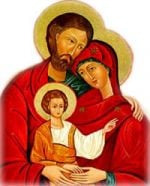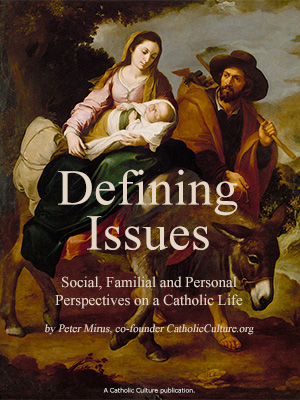A pontificate marked by contradictions
By Phil Lawler ( bio - articles - email ) | Apr 21, 2025
From the date of his election—March 13, 2013—to the time of his death on Easter Monday, the pontificate of Pope Francis was marked by surprises and novelties, contradictions and confusion.
When he first appeared at the loggia of St. Peter’s basilica, and began his remarks with a simple “Buonasera,” the new Pope stirred public interest with his informal style. The first Pontiff from the Western hemisphere, the first Jesuit ever chosen for Peter’s Throne, he was something entirely new and unexpected. Largely unknown to the Catholic world, he had never worked at the Vatican, and had not been listed among the papabile entering the conclave. His personal manner, in marked contrast to that of the retired Pope Benedict XVI, was gregarious and breezy.
The “Francis effect” was immediate, and huge crowds flocked to St. Peter’s Square for the first public audiences of the new pontificate. The mass media, recognizing a newsworthy subject, fueled the excitement, giving Pope Francis the favorable treatment that he would enjoy throughout the next twelve years.
But shadows of doubt soon emerged from the glow of that publicity. Careful observers noted that the newly elected Pope had refused to don the traditional vestments of the papacy. Journalists covering the Vatican were taken aback when, after meeting with them during his first week, he declined to give them his blessing.
Those shadows grew longer as the Pope’s penchant for pithy remarks soon produced headline quotations. Asked about reports that a Vatican official was homosexual, Francis asked: “Who am I to judge?” At World Youth Day in Rio de Janeiro he encouraged young people to “Hagan lio!”—“Make a mess!” These were not the sort of quotations anyone expected from the Roman Pontiff. The shock value of these statements delighted headline-hungry reporters and critics of the Catholic Church, while unsettling Catholics of more traditional stripe. So the pattern was set for the pontificate.
The promise of reform
In the general congregations leading up to the conclave that elected Pope Francis, the members of the College of Cardinals had focused on the need for reforms at the Vatican: reforms that would address the damage done by the sex-abuse scandal and the revelations of Vatican financial mismanagement. By taking the name “Francis” the new Pope signaled his desire to bring a humbler approach to the Vatican; he reinforced that message by declining to take up residence in the papal apartment of the apostolic palace, opting instead for a suite in the Vatican’s guest house.
Although he had been offered as a liberal alternative to Cardinal Ratzinger at the last previous conclave, relatively little was known about Cardinal Bergoglio’s views on matters of Catholic doctrine and discipline in 2013. In any case he was not expected to be a teaching Pontiff. Following two great teachers, who had produced masterpieces of theological and philosophical reflection on the tensions between Christian faith and modern society, the new Pope from Argentina was expected to focus on management—the one aspect of the papacy that neither John Paul II nor Benedict XVI had mastered.
But Francis had other ideas. He too became a teaching Pope, in a radically different way. Rather than producing formal theological statements (he issued only four encyclicals, one of which Pope Benedict had left in partial draft form), he posed questions and criticized presumptions, probing at the perceived weaknesses of traditional Catholic beliefs. As Archbishop of Buenos Aires, Cardinal Bergoglio had avoided interviews. Now, in a complete reversal, he submitted to dozens of impromptu question-and-answer sessions, frequently raising eyebrows with his unprepared remarks.
The Pope’s most provocative comments came during informal exchanges with the reporters who accompanied him on his overseas voyages. During the course of his pontificate he made 47 trips abroad (not counting shorter visits to locations in Italy). Altogether he visited 68 different countries, including several (Iraq, South Sudan, Bahrain, Myanmar) that had never before hosted a Bishop of Rome. Oddly, though, he never returned to his native Argentina.
Back in Rome, meanwhile, the enthusiasm that had greeted the Pope’s election gradually subsided; the large crowds at papal audiences thinned out, and in the later years of his pontificate Francis spoke to thousands of empty seats in St. Peter’s Square. Inside the walls of the Vatican, the Pope’s approach to management proved no more effective than that of his immediate predecessors. In his first December meeting with the leaders of the Roman Curia—an event traditionally seen as an exchange of Christmas greetings—he lashed out angrily at what he saw as the deficiencies of his aides, with predictably negative consequences for staff morale. As the years passed by, Francis’s peremptory governing style, his intolerance for criticism, and his failure to consult with colleagues contributed to a climate of fear in the Curia.
So the early promises of the pontificate were never realized. Even the friendly New York Times, in its announcement of the Pope’s death, acknowledged: “Early hopes that a ‘Francis effect’ would bring the faithful back to the pews mostly failed to materialize as church attendance continued to fall in the secularized West even as it grew in the global South.”
Fault lines and contradictions
”In many ways,” the same Times report observed, “Francis used his tenure to change the course pursued by his predecessors Benedict XVI and John Paul II.” Both of those Pontiffs had been active participants in the discussions of Vatican II, and sought to clarify the teachings of that Council in the context of the perennial Catholic tradition. Pope Benedict in particular had insisted on a “hermeneutic of continuity,” explaining that Vatican II should be seen as a development of—not a break from—that constant tradition.
The message of the Francis pontificate was radically different. He frequently took aim at venerable Catholic teachings and practices, denouncing the “doctors of the law” who upheld traditional moral teachings. At several points in his pontificate, his statement (or statements he explicitly approved) seemed to contrast with defined teachings of the Church. In Amoris Laetitia he suggested that Catholics who divorce and remarry may receive the Eucharist, in a clear break from magisterial teaching. In Fiducia Supplicans, the Vatican advanced the possibility of blessings for same-sex couples. Each of these statements drew questions from leading prelates, asking how the new teaching could be reconciled with Church doctrine. Francis declined to answer those questions directly.
In his most startling statements, Pope Francis never directly contradicted established Catholic doctrine. But by raising questions about previous teachings, and then remaining silent while more radical clerics proclaimed a change in doctrine, he undermined the traditional teachings—and paradoxically undermined his own authority, since if one Pope can contradict the teaching of a previous Pope, the next Pope might reverse the process. The net effect of his odd teaching method—as I explained in my book Lost Shepherd—has been to create widespread confusion among the faithful about what the Church actually does teach.
The years of the Francis pontificate were marked with contrasts and contradictions:
- The Pope issued admirably clear denunciations of legal abortion and gender ideology, yet he regularly showed his favor toward public officials and even clerics who promoted those causes.
- He championed the cause of human rights, but curried favor with the Communist Chinese regime that trampled on the rights of dissenters, ethnic minorities, and religious believers—notably including Catholics. He denounced capital punishment and decried pollution, but overlooked China’s leading role in both.
- He spoke constantly about decentralized authority in the Church, but tightened his own control. His signature achievement, the Synod on Synodality, was marked by a steady pressure from the organizers to achieve his favored results, and even then he removed several critical issues from the agenda to be handled by his own select committees.
- He urged pastors to reach out to “the peripheries,” to “accompany” those who might feel alienated from the Church, and to encourage diverse movements within Catholicism, yet he did his utmost to suppress the growing interest—particularly among young Catholics—in the traditional Latin liturgy.
- He routinely ignored the canon law, making administrative changes that conflicted with the Church’s own regulations (even though he had authority to change the law), yet he set a record-breaking pace for the use of the motu proprio, by which he used his authority to change canon law without consultation.
The pontificate began with great hopes of reform. And even at the time of his death, most mainstream media accounts credited Francis with making strides toward an end to scandals of clerical abuse and Vatican financial misconduct. But objective reporters have remarked that the late Pope, despite his repeated promises, never brought true transparency to the handling of complaints about bishops who protected abusers. Worse, Francis had a track record of defending and promoting accused abusers (Ricca, Barros, Zanchetta, McCarrick, Rupnik) himself. And while the Vatican has regained the confidence of European banking inspectors, the Vatican’s judicial system has been exposed to international criticism for its failure to provide due process in the “trial of the century,” a cardinal convicted of fraud has made plausible claims that he was framed, and a former auditor general is suing the Vatican for improper termination, arguing—again plausibly—that he was fired because he was unearthing inconvenient truths. The promise of reform remains unfulfilled.
All comments are moderated. To lighten our editing burden, only current donors are allowed to Sound Off. If you are a current donor, log in to see the comment form; otherwise please support our work, and Sound Off!
-
Posted by: feedback -
Apr. 23, 2025 6:06 PM ET USA
The secret China deal was the opposite to the shepherd laying down his life for the sheep. John 10:11. The secrecy needs to be exposed.
-
Posted by: ewaughok -
Apr. 21, 2025 6:08 PM ET USA
You were right, mr. Lawler, he was the Lost Shepherd. His confusion and ambivalence about the Catholic faith was deep-seated, indeed at the very heart of the man. he could condemn the form of the mass that the church celebrated were hundreds of years, and in the next breath, praise Martin Luther! Synodality turned out to be whatever he wanted at the moment. His last frenetic run through Saint Peter’s a little over a week ago, is a sort of synecdoche for his whole confused papacy.








